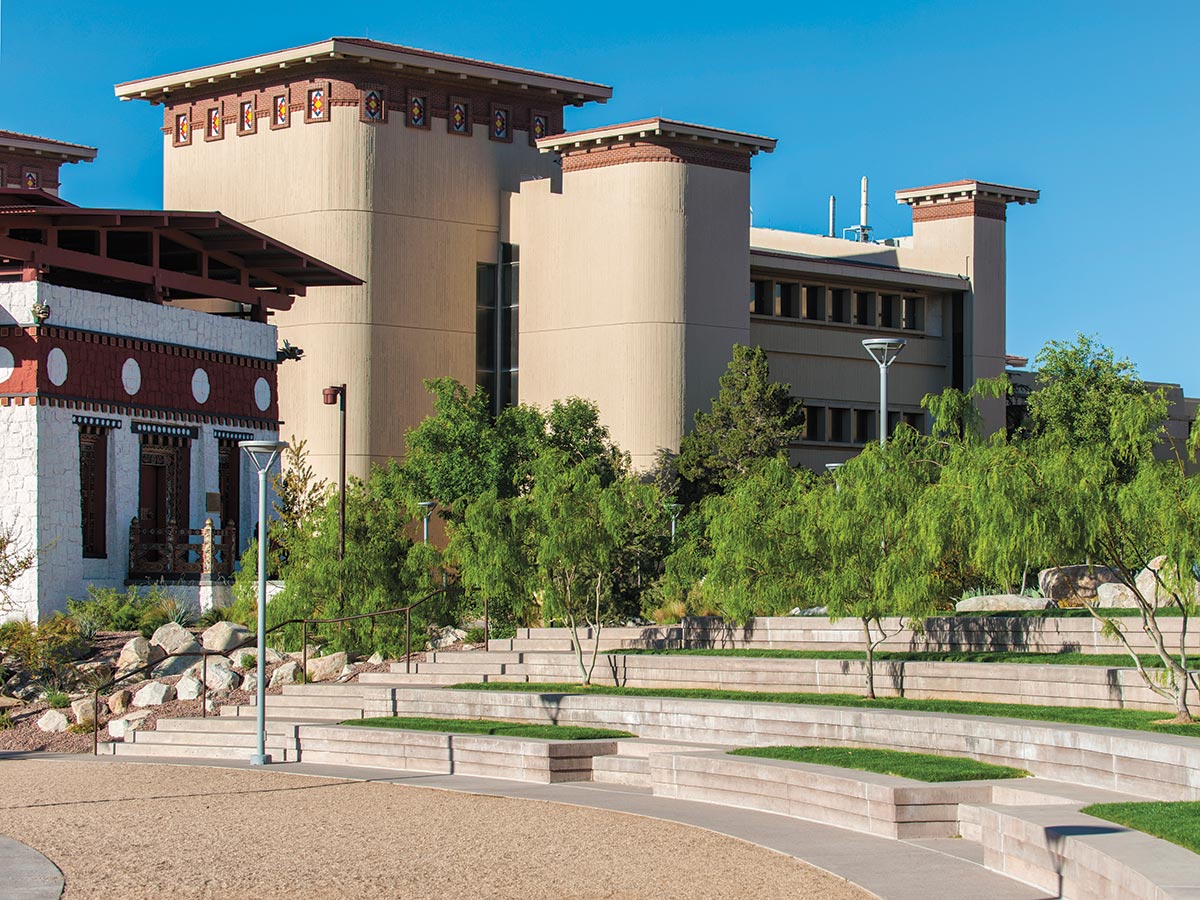Living Proof

The University of Texas at El Paso is just one of many Tree Campuses in Texas, where university tree canopies are used as opporunities for education and public service. PHOTO Adam Barbe
Everyone, it seems, appreciates a nice, shady spot. That includes students at The University of Texas at El Paso, people from its nearby neighborhoods, and on-campus birds, squirrels and even denning foxes.
After a campus transformation project that replaced parking lots and streets with pathways, native vegetation and trees, the campus simply became “more alive,” says Greg McNicol, associate vice president for business affairs and facilities management.
UTEP is one of 27 Texas universities certified as a Tree Campus by the Arbor Day Foundation. The program recognizes colleges and universities that effectively manage their trees, foster healthy urban forests and engage students. Participating institutions must have a tree care plan and funding, observe Arbor Day, offer a service learning project, and name a tree advisory committee.
In return, Tree Campuses enjoy the many benefits of trees, from shade and a pleasant place to relax or work out-of-doors to improved well-being and reduced energy use. In cities, sparse vegetation and heat-absorbing surfaces create a heat island effect, meaning temperatures are higher than in less-developed areas nearby (surface temperatures over asphalt, for instance, can be up to 53 degrees warmer than over vegetated areas). According to a Nature Conservancy report on air quality and urban trees, the benefits per dollar spent on trees are similar to those of other methods for lowering outdoor air temperatures, such as white roofs.
The same Nature Conservancy analysis found that spending just $4 per resident on planting trees could improve the health of millions of people in large cities; tree leaves filter out fine particulate matter, a particularly dangerous form of air pollution that contributes to 3.2 mil- lion deaths per year — primarily from cerebrovascular and ischemic diseases (which cause strokes and heart attacks, respectively). Another study, from the State University of New York’s College of Environmental Science and Forestry, found that trees can save cities of 10 million people more than $500 million annually in health care, energy and environmental protection. Each Tree Campus contributes to such benefits as part of a city’s overall tree canopy.
The 4,800-plus trees on the University of Texas at Austin campus provide nearly $550,000 in annual benefits.
Dallas Baptist University first received recognition as a Tree Campus in 2012 and has planted more than 2,600 trees in the past 19 years, including a variety of native oaks (Quercus spp.), cedar elm (Ulmus crassifolia), red maple (Acer rubrum), black walnut (Juglans nigra) and Texas redbuds (Cercis canadensis var. texensis).
“We wanted students to know the value of trees, and Tree Campus was a good format,” says DBU Director of Landscaping and Special Projects Robert Erickson. The university also works with area schools and the city planting trees off campus to increase both the urban tree canopy and public awareness.
The 4,800-plus trees on the University of Texas at Austin campus provide nearly $550,000 in annual benefits, from carbon storage and improved air quality to reduced erosion, healthier soil and noise buffering, says UT arborist Jim Carse. The trees also contribute to the general well-being of those on campus, and nurturing trees long-term has additional benefits: Five 10-inch tree trunks don’t replace the loss of one 50-inch diameter tree, says Carse. This is because mature trees process more carbon dioxide, absorb more particulates and have larger, more established root systems than younger trees.
A Tree Campus for nine years, UT plants native species including southern live oak (Quercus virginiana); chinquapin, Mexican white and Shumard oaks (Q. muehlenbergii, Q. polymorpha and Q. shumardii, respectively); Montezuma cypress (Taxodium mucronatum); and pecan (Carya illinoinensis). Native species are important for a variety of reasons, according to Carse, including providing a local seed source. For those who want to dig deeper, an online database includes species, size and location of specific trees at UT, as well as information on their individual benefits. The database updates nightly.
“The app is a way to educate people not only about individual trees but also the benefits of trees and nature in general in cities,” says graduate student Daniel Alvarado, student representative on UT’s Tree Campus committee. “Those benefits are really noticeable on campus.”
Some 5,000 trees shade the campus of University of Houston, named a Tree Campus in 2016. Sustainability Coordinator Melissa Halstead says the program was a way for UH to be a better steward of its trees. Student Alex Rogers, who has participated in tree plantings with the program, agrees: “The program is important because it feels like a larger focus on ecological sustainability,” he says. The UH plan includes a tree inventory conducted by students under the guidance of faculty and foresters, which Halstead says will give the university a better handle on what grows on campus.
The University of Texas at El Paso maintains a database of its 3,000 trees, which represent 180 species, including natives such as madrone (Arbutus xalapensis), persimmon (Diospyros spp.), ash (Fraxinus spp.), mesquite (Prosopis spp.), pinyon pines (Pinus spp.), oaks (Quercus spp.) and junipers (Juniperus spp.). The university is working on a smartphone app that visitors can use to look up information on individual trees.
“Shade is an important part of creating a pleasant environment,” says UTEP’s McNicol. It’s a claim that’s easy to witness in the flesh and bark: Students, faculty and visitors hanging out under trees on campuses around Texas — and wildlife living in and around them — provide living proof.
Melissa Gaskill writes about science, nature and the environment for a variety of publications, including Mental Floss, Newsweek and Men’s Journal, and has published books about hiking and sea turtle conservation tourism. She became personally acquainted with the pleasures of campus trees while earning a zoology degree at Texas A&M University and a master’s in journalism at The University of Texas at Austin.

